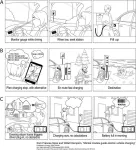(Press-News.org) Two of the biggest challenges faced by new and potential electric vehicle (EV) drivers are range anxiety and speed of charging, but these shouldn’t have to be challenges at all. That is according to a study by Chalmers University of Technology, Sweden, and the University of Delaware, USA. Researchers discovered that a change in refuelling mindset, rather than improving the size or performance of the battery, could be the answer to these concerns.
The transition from filling up at a petrol station to recharging your electric vehicle in the most convenient location for you, requires a whole new way of thinking about refuelling a car. However, new EV drivers often remain in their old mindset and get stuck constantly checking the gauge and planning for the next charge point. This can lead drivers to feel anxious. But what if they are thinking about it all wrong?
Researchers have now identified three different types of behaviour around refuelling a car, which are described in the recently published paper, “Mental models guide electric vehicle charging”. They are:
1. The monitor fuel gauge model – the driver refuels when the fuel is running out
2. The planning a trip model – the driver plans when and where they will stop to refuel their vehicle along a journey
3. The event-triggered model – e.g. the driver automatically plugs in as soon as arriving home or work
The first model represents how most people refuel a petrol or diesel car, and the third model is the best for optimum electric vehicle usage.
“Experienced electric vehicle users have chosen an event or location to trigger their plug-in; for example, they will automatically plug in when they come home or get to work, so it becomes part of their morning or evening routine, which makes it less of a chore to think about charging. There is a lot of emphasis on the time it takes to charge an EV, but if you do it overnight, it is just the time it takes to plug it in. So really, it is just the long trips that you need to plan for,” says Professor Frances Sprei, of Chalmers University of Technology, who led the study, along with Willett Kempton from the University of Delaware.
The right infrastructure in the right places
This change in mindset requires the right infrastructure in the right places. The best places to charge for a long time, are either at home or at work, since people spend long periods of time there already, so charge points need to be available to people in these locations.
In contrast to this, a lot of European cities are currently focusing on roadside charging, which might conflict with the needs of other road users, such as pedestrians and cyclists.
“In order for people to be able to use EVs in the best possible way, policies need to adapt to ensure that people have access to charging infrastructure close to their home or workplace where possible”, says Professor Frances Sprei.
The biggest battery isn’t always the best
This change in mindset could also encourage more people opting for an electric vehicle, in order to reach global and European emissions targets.
For potential EV drivers, there is also the question of battery size to reduce range anxiety.
“We do see a trend, that you need to have this really large battery. But according to other research, you will generally be ok with a slightly smaller battery than the range you would have on a gasoline tank, since the only time you would need a larger range is for a six hour or longer journey, in which case the driver could charge on the go. There is too much emphasis on the need for really long ranges, and this leads to increased price for the vehicle and increased resource use of the EVs,” says Professor Sprei.
In conclusion, for most people’s everyday driving, the new study shows that you don’t have to think too much about charging at all. In terms of cost, it is also a lot cheaper to charge slowly overnight or at work than fast charging on the go, and it is better for the health of the battery.
More about the research:
The research is presented in an open-access paper: "Mental models guide electric vehicle charging", published in the journal Energy.
The researchers involved in the study are Frances Sprei from Chalmers University of Technology, Sweden, and Willett Kempton from the University of Delaware, USA. This work was supported by the Swedish Energy Agency. The authors would also like to recognise the contribution of Niklas Jakobsson for interviews of the novice EV users, Sten Karlsson for the project management of the research project from which the novice interviews were drawn, and Stephanie McClellan for editorial advice.
For more information, please contact:
Frances Sprei, Professor, Division of Physical Resource Theory, Department of Space, Earth and Environment, Chalmers University of Technology, Sweden frances.sprei@chalmers.se +46 31 772 21 46
The contact person speaks English, Swedish, Italian and French, and is available for live and pre-recorded interviews. At Chalmers, we have podcast studios and broadcast filming equipment on site and would be able to assist a request for a television, radio or podcast interview.
NOTE TO THE EDITOR - IMAGES:
The Chalmers Press portal can be accessed here and you can search for any images or videos.
We kindly request credit to be given in the following format where possible:
Image/Graphic/Illustration: Chalmers University of Technology | Name Surname
Images provided in Chalmers University of Technology press releases are, unless specified otherwise, free for download and publication as long as credit is given to the University and the individual creator. Cropping and rescaling of the images is permitted when required for adaptation to the publication’s format, but modifications that would influence the message and content of the original are not. The material is primarily intended for journalistic and informative use, to assist in communication and coverage of Chalmers’ research and education. Commercial usage, for example the marketing of goods and services, is not permitted.
END
How electric vehicle drivers can escape range anxiety
2024-04-25
ELSE PRESS RELEASES FROM THIS DATE:
How do birds flock? Researchers do the math to reveal previously unknown aerodynamic phenomenon
2024-04-25
In looking up at the sky during these early weeks of spring, you may very well see a flock of birds moving in unison as they migrate north. But how do these creatures fly in such a coordinated and seemingly effortless fashion?
Part of the answer lies in precise, and previously unknown, aerodynamic interactions, reports a team of mathematicians in a newly published study. Its breakthrough broadens our understanding of wildlife, including fish, who move in schools, and could have applications in transportation and energy.
“This area of research is important since animals are known to take advantage of the flows, such as of air or water, left by other members of ...
Experts call for global genetic warning system to combat the next pandemic and antimicrobial resistance
2024-04-25
The Covid-19 pandemic turned the world upside down. In fighting it, one of our most important weapons was genomic surveillance, based on whole genome sequencing, which collects all the genetic data of a given microorganism. This powerful technology tracked the spread and evolution of the virus, helping to guide public health responses and the development of vaccines and treatments.
But genomic surveillance could do much more to reduce the toll of disease and death worldwide than just protect us from Covid-19. Writing in Frontiers in Science, an international collective of clinical and public health microbiologists ...
Genetic variations may predispose people to Parkinson’s disease following long-term pesticide exposure, study finds
2024-04-25
A new UCLA Health study found certain genetic variants could help explain how long-term pesticide exposure could increase the risk of Parkinson’s disease.
While decades of research have linked pesticide exposure and Parkinson’s disease risk, researchers have sought to explain why some individuals with high exposure develop the disease while others do not.
One longstanding hypothesis has been that susceptibility to the disease is a combination of both environmental and genetic factors.
The new study, published in the journal NPJ Parkinson’s Disease, used genetic data from nearly 800 Central Valley (California) residents with Parkinson’s ...
Deer are expanding north, and that’s not good for caribou
2024-04-25
As the climate changes, animals are doing what they can to adapt.
Researchers from UBC Okanagan—which includes partners from Biodiversity Pathways’ Wildlife Science Centre, the Alberta Biodiversity Monitoring Institute, the University of Alberta, and Environment and Climate Change Canada—wanted to evaluate why deer densities in the boreal forest are rapidly increasing.
Over the past century, white-tailed deer have greatly expanded their range in North America, explains Melanie Dickie, a doctoral student with UBC Okanagan’s Wildlife Restoration Ecology Lab.
In the boreal forest of Western Canada, ...
Puzzling link between depression and cardiovascular disease explained at last: they partly develop from the same gene module
2024-04-25
Depression and cardiovascular disease (CVD) are serious concerns for public health. Approximately 280 million people worldwide have depression, while 620 million people have CVD. It has been known since the 1990s that the two diseases are somehow related. For example, people with depression run a greater risk of CVD, while effective early treatment for depression cuts the risk of subsequently developing CVD by half. Conversely, people with CVD tend to have depression as well. For these reasons, the American Heart Association (AHA) advises to monitor teenagers with depression ...
Synthetic droplets cause a stir in the primordial soup
2024-04-25
Our bodies are made up of trillions of different cells, each fulfilling their own unique function to keep us alive.
How do cells move around inside these extremely complicated systems? How do they know where to go? And how did they get so complicated to begin with? Simple yet profound questions like these are at the heart of curiosity-driven basic research, which focuses on the fundamental principles of natural phenomena. An important example is the process by which cells or organisms move in response to chemical signals in their environment, also known as chemotaxis.
A constellation of researchers from three different research units at the Okinawa Institute of Science ...
Future parents more likely to get RSV vaccine when pregnant if aware that RSV can be a serious illness in infants
2024-04-25
A nationwide survey of people who were pregnant or trying to become pregnant found that overall 54 percent expressed interest in the RSV vaccine during pregnancy. Perceiving RSV as a serious illness in infants was the strongest predictor of likely vaccination during pregnancy. Likelihood to receive the RSV vaccine during pregnancy was also higher among parents with a child at home already. Findings were published in the journal Pediatrics.
Respiratory syncytial virus (RSV) is a leading cause of infection among infants, frequently resulting in hospital or intensive care admission. RSV infection severe enough to require hospitalization has been associated with long-term wheezing ...
Microbiota enterotoxigenic Bacteroides fragilis-secreted BFT-1 promotes breast cancer cell stemness and chemoresistance through its functional receptor NOD1
2024-04-25
Tumor-resident microbiota in breast cancer promotes both the initiation and progression of cancer. However, the potential of targeting microbiota to enhance the efficacy of breast cancer treatment has not been comprehensively explored. In this study, researchers analyzed the microbial composition within breast tumors and identified a notable enrichment of ETBF in patients who exhibited resistance to taxane-based neoadjuvant chemotherapy.
Key findings from the study include:
Even at low biomass levels, ETBF ...
The Lundquist Institute receives $2.6 million grant from U.S. Army Medical Research Acquisition Activity to develop wearable biosensors
2024-04-25
The U.S. Army Medical Research Acquisition Activity (USAMRAA) has awarded The Lundquist Institute (TLI) a four-year grant totaling $2,623,234. The research project is led by Dr. Harry Rossiter, an investigator at TLI and Professor at the David Geffen School of Medicine at UCLA. The project aims to develop wearable multiplex biosensors to monitor exacerbation risk in chronic obstructive pulmonary disease (COPD).
COPD affects approximately 16 million Americans and is the third leading cause of death globally. Acute exacerbations of COPD (AECOPD), typically caused by a lung infection, are associated ...
Understanding the cellular mechanisms of obesity-induced inflammation and metabolic dysfunction
2024-04-25
A research team led by Professor Jong Kyoung Kim and Yujin Jeong (PhD candidate), from the Department of Life Sciences at Pohang University of Science and Technology (POSTECH) in collaboration with Professor Yun-Hee Lee and Cheoljun Choi (PhD candidate) from the College of Pharmacy at Seoul National University, Professor Young-Min Hyun and Koung-Min Park (PhD candidate) from Yonsei University College of Medicine, Professor James Granneman from Wayne State University (WSU), and Professor Young-Suk Jung from the College of Pharmacy at Pusan National University, ...









